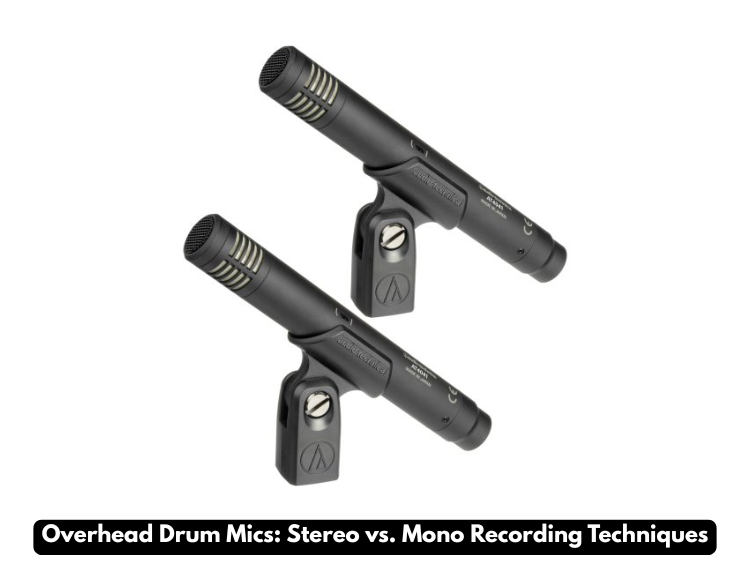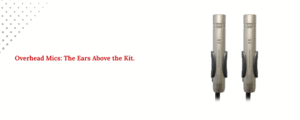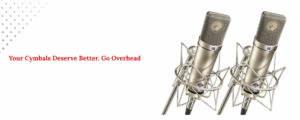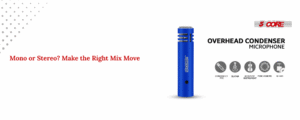Overhead mics are a terrific method to capture the intensity and emotion of a drum set. They do more than one thing; they make the full drum set sound better. One of the first things engineers have to do when they set them up is choose between stereo and mono. There are good and bad things about every decision, and some function better than others in particular situations. This article will go into depth about both ways so you can choose the one that works best for your recording style and goals.
What Are Drum Mics Overhead?
When you position an overhead drum mic above a drum set, it generally picks up the sound of the complete kit, the cymbals, and the room. Overhead microphones provide you with a fuller sound image than near mics, which only catch up one beat at a time. The placement of the drums and whether they are recorded in mono or stereo have a big impact on how they fit into a mix.
For more insight on choosing the right microphones, check out the Top Drum Mic Kits for Beginners – All-in-One Solutions for New Drummers.
Do You Know What It Means to Use a Mono Overhead Mic?
A mono overhead setup features one microphone above the kit, usually in the center, so it can hear everything well.
Pros of Mono Overheads:
- Phase Coherence: Because there is just one mic, there can’t be any phase issues between the left and right channels.
- Easier to Set Up: It requires less time and equipment to set up, which makes it great for live events or simple setups.
- Tight Focus: Mono can generate a strong drum sound that is easy to include in a mix.
- Genre Suitability: Mono makes the drums stand out in punk, metal, or lo-fi genres when stereo breadth isn’t as vital. It doesn’t make the stereo field too wide.
Cons of Mono Overheads:
- Lack of Spread: You lose the kit’s natural left-to-right spread, which may make the drums sound flat or less “live.”
- Less Realistic: The kit may seem less real or compressed in space without the stereo’s spatial clues.
Do You Know What Stereo Overhead Miking Is?
When you stereo mic, you use two microphones to capture the drum set in a manner that makes it sound as it would in real life.
Stereo Techniques:
- A/B Spaced Pair: Two mics that are spaced apart, generally on the left and right sides of the kit.
- X/Y: Two cardioid microphones set up near to each other at a 90° angle to retain the phase but cut down on the range.
- ORTF: A halfway ground between A/B and X/Y that gives you natural audio breadth and excellent phase constancy.
- Glyn Johns: A technique to mix stereo that also employs a near snare mic.
To compare mic types for this technique, see Dynamic vs Condenser Drum Mics: Which Should You Buy for Your Needs?.
Pros of Stereo Overheads:
- Natural Soundstage: The cymbals, toms, and snare all sound like they’re in the room, and the drum set sounds like it’s in the room.
- Better Immersion: Stereo overheads make jazz, rock, indie, and acoustic music seem more authentic and full.
- More Ways to Mix: You may pan the sound more, and the drums will sound more “alive” in the mix.
Cons of Stereo Overheads:
- Phase Problems: If the speakers aren’t lined up or positioned appropriately, they might lose phase, which makes the music weaker.
- Extra Tools and Time: It takes longer to set up two microphones since you need extra stands, wiring, and channels.
- Room Dependence: Stereo overheads tend to take up more room tone, which is good in a well-treated room but problematic in a poorly treated room.
For durable, high-quality gear that suits these setups, visit Drum Microphones for Sale – Legendary Durability & Sound Quality.
When to Use Mono or Stereo
There are occasions when mono or stereo overheads are the best choice.
Use Mono When:
- You’re in a tiny room that hasn’t been cleaned.
- You can only utilize a certain number of microphones, channels, or minutes.
- You’re recording music that doesn’t care about stereo spread, including punk, lo-fi, and garage rock.
- It should sound like music from the past, like Motown or the Beatles’ early work.
- You want the greatest attention and punch you can get.
Use Stereo When:
- You want the drums to sound huge, broad, and deep.
- You’re making jazz, pop, or rock music that has a lot to do with space.
- You have the time and the tools to fix the situation.
- You can record in a room that sounds like a real room.
- There has to be some room for creativity in post-production.
Conclusion
Overhead mics are incredibly useful for hearing how a drum set sounds in a mix. You may select between mono and stereo depending on the song, the setting, the gear, and what you want to do creatively.
- Mono overheads are wonderful for basic recordings since they are easy to use, dependable, and sound terrific.
- Overhead stereo speakers provide breadth, depth, and realism to sound, making them great for full-range professional performances.
The finest engineers know how to employ both ways when the time comes. Listen to both and see which one you like more.




